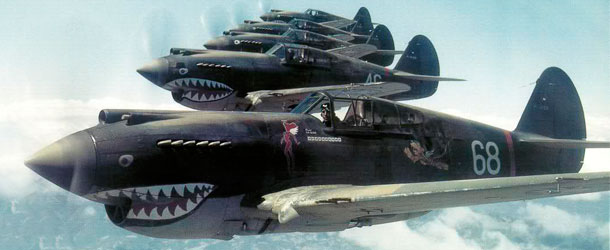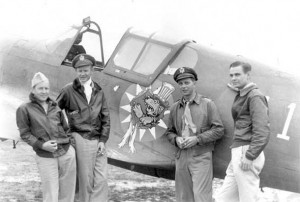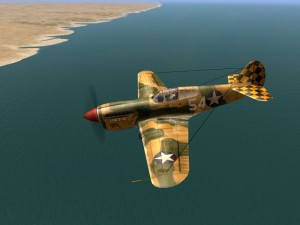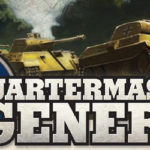The P-40 is most known as "Warhawk" - the official name in the United States for all P-40s, but it’s also named "Tomahawk" –used by the British Commonwealth and Soviet air forces for the variants P-40B and P-40C, and "Kittyhawk", for the P-40D and all later variants.
The most numerous US Army fighters during WW2, the single-engine, single-seat, all-metal Curtiss P-40 Warhawk battled on every continent, being used by the air forces of 28 nations, from June 1941 until the end of the war. With 13,800 planes produced, it was the workhorse of the Allied aerial arsenal. Its design was based on the earlier P-36, mated to the Allison V-1710 engine, which Curtiss was able to produce in large numbers. That allowed its rapid entry in production and operational service.
Despite criticisms of the inferiority of its design compared to fighters like the Bf.109, Zero, Spitfire and Messerschmitt, especially in high-altitude combat, it was considered outstanding in providing close support to ground troops and excellent when primitive maintenance, terrible weather and heavy odds were the order of the day. The P-40's good qualities included pilot armor, self-sealing fuel tanks, sturdy construction, heavy armament - six 12.7mm (0.50 cal) machine guns in the wings; provision for 227 kg (500 lbs) bomb or 197 litres drop tank under fuselage -, and a high diving speed.
The P-40 played a critical role for the Allied air forces in three major theaters: North Africa, the Southwest Pacific and China. It also had a significant role in the Middle East, Southeast Asia, Eastern Europe, Alaska and Italy.
The plane won fame with General Chennault's 'Flying Tigers' - the 1st American Volunteer Group (AVG) of the Chinese Air Force in 1941–1942, composed of pilots from the United States Army (USAAF), Navy (USN), and Marine Corps (USMC), recruited under presidential sanction and commanded by Claire Lee Chennault. The group consisted of three fighter squadrons with about 20 aircrafts each and had the mission of defending China against Japanese forces.
In China, Chennault found out that the P-40 was heavier, faster, and sturdier than Japanese fighters, and it out-gunned them as well. The P-40 advantages were speed in a dive, superior firepower, and better ability to absorb battle damage. Chennault worked out and documented the appropriate tactics that capitalized on the relative strengths of the American fighters: intercept, make a diving pass, avoid dogfighting, and dive away when in trouble. This remained the fundamental U.S. fighter doctrine throughout the Pacific War.
AVG fighter aircrafts were painted with a large shark face on the front of the aircraft. The Tigers' shark-faced fighters remain among the most recognizable individual combat aircrafts of World War II, and they demonstrated innovative tactical victories at a time when the news in the U.S. were filled with little more than stories of defeat at the hands of the Japanese forces.
The P-40 versions included in the Wings of Glory WW2 Airplane Packs are a shark-faced Flying Tiger piloted by General David Lee “Tex” Hill and a plane used by Captain William M.Lott from the 325th Fighter Squadron.
David Lee “Tex” Hill is one of the most famous American aces of WW2. He first joined the torpedo squadron on the USS Saratoga in 1939, and later was part of a Vought SB2U Vindicator dive bomber squadron aboard USS Ranger. In 1941, he was recruited to join the 1st American Volunteer Group - Flying Tigers.
He learned to fly the P-40 in the AVG training program in Burma, and did well as a fighter pilot in the 2nd Pursuit Squadron (Panda Bear) as a flight leader and then squadron commander. His first victory came on January 3, 1942, when he downed two Nates over the Japanese airfield at Tak, Thailand; he shot down two more, 20 days later, and on the 24th he shot down a fighter and a bomber over Rangoon, becoming an ace. In March, he became the Leader of the AVG’s Second Squadron. In July 2012, when the AVG was disbanded, Hill was a double ace, credited with 12 victories.
Hill was one of only five Flying Tigers to join its USAAF successor, the USAAF 23rd Fighter Group, with the rank of major. He activated the 75th Fighter Squadron and later commanded the 23rd Fighter Group as a Colonel. Before returning to the states in late 1944, Hill and his P-51 scratched another six Japanese aircraft. He was credited with destroying 18.25 enemy aircraft totally - the 0.25 kills comes from an assist; he and 3 other pilots worked together to shoot down a Nate.
After he returned to the U.S., Hill was commander of the 412th Fighter Group, America's first operational jet fighter group, flying the P-59 Airacomet and the P-80 Shooting Star. He retired from active service in 1945. One year later, he was asked by Texas Governor Coke Stevenson to activate and accept command of the 58th Wing of the Texas Air National Guard. Hill became the youngest Brigadier General in the history of the Guard, and he once again saw combat during the Korean War with the Texas Air Guard.
He retired from the military career as a Brigadier General in the Air Force Reserves and holding numerous awards - Distinguished Service Cross, Silver Star, Distinguished Flying Cross with three Oak Leaf Clusters, Presidential Unit Citation with Oak Leaf Cluster, Chinese Order of the Cloud and Banner 4th, 5th and 6th grades, 2-Star Wing Decorations, Chinese Victory Medal, Legion of Merit, and British Distinguished Flying Cross.
The second P-40 features in the Wings of Glory WW2 Airplane Packs is the model operated by the Captain William Lott, from the 318th Fighter Squadron, which together with the 317th and 319th squadrons formed, in 1942, the 325th Fighter Group that operated in the Mediterranean Theater.
The 325th trained in the U.S. with P-40s, before moving to North Africa by ship and transport planes, in January–February 1943. It entered combat in April 1943 escorting medium bombers, flying strafing missions, and conducting sea sweeps from bases in Algeria and Tunisia. The group participated in the defeat of Axis forces in Tunisia, the reduction of Pantelleria, and the conquest of Sicily. The William Lott's airplane presented in the Wings of Glory was used in Tunisia and has the pilot's name - Lott-o - painted over the boar in the front of the aircraft.
Top image: The P-40 Flying Tigers, from the 1st American Volunteer Group of the Chinese Air Force. Credits: www.military-aircraft.org.uk
Information sources: AcePilots.com, WW2 Aircraft, Wikipedia.












